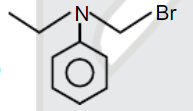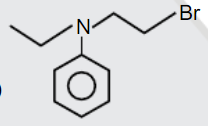Which one is most reaction towards AgNO3




The correct Answer is:A
To determine which compound is most reactive towards silver nitrate (AgNO₃), we need to analyze the stability of the carbocations formed during the reaction. The compound that forms the most stable carbocation will be the most reactive.
1. Understanding the Reaction:
When a compound (let's call it R-X) reacts with AgNO₃, it forms a precipitate of AgX and releases a nitrate ion (NO₃⁻). The key to understanding the reactivity lies in the stability of the carbocation (R⁺) that forms when X leaves.
2. Identifying the Compounds:
Let's consider the four options provided (though not explicitly listed here, we will assume they are typical organic compounds with different leaving groups):
- Option 1: R-NH₂ (amine)
- Option 2: R-Br (alkyl bromide)
- Option 3: R-OH (alcohol)
- Option 4: R-Ph (aryl compound)
3. Formation of Carbocations:
- For each of these compounds, when the leaving group (X) departs, a carbocation is formed. The stability of this carbocation is crucial for determining the reactivity.
- Option 1: The lone pair on nitrogen can stabilize the positive charge through resonance.
- Option 2: The bromide ion (Br⁻) leaves, forming a carbocation that can be stabilized by hyperconjugation and inductive effects.
- Option 3: The hydroxyl group (OH) leaves, forming a carbocation that is less stable due to the lack of effective resonance stabilization.
- Option 4: The aryl compound may form a carbocation that is stabilized by resonance, but the presence of the phenyl group can also create steric hindrance.
4. Comparing Stability:
- The stability of carbocations generally follows this order: tertiary > secondary > primary > methyl.
- The presence of electron-donating groups (like nitrogen in amines) can stabilize carbocations through resonance.
- In this case, the nitrogen in option 1 can donate its lone pair effectively, making the carbocation more stable compared to the others.
5. Conclusion:
Based on the analysis, the compound that forms the most stable carbocation when reacting with AgNO₃ is the one with nitrogen (option 1). Therefore, the most reactive compound towards AgNO₃ is the one that forms the most stable carbocation.
Final Answer:
The compound that is most reactive towards AgNO₃ is Option 1 (R-NH₂).
When a compound (let's call it R-X) reacts with AgNO₃, it forms a precipitate of AgX and releases a nitrate ion (NO₃⁻). The key to understanding the reactivity lies in the stability of the carbocation (R⁺) that forms when X leaves.
Let's consider the four options provided (though not explicitly listed here, we will assume they are typical organic compounds with different leaving groups):
- Option 1: R-NH₂ (amine)
- Option 2: R-Br (alkyl bromide)
- Option 3: R-OH (alcohol)
- Option 4: R-Ph (aryl compound)
- For each of these compounds, when the leaving group (X) departs, a carbocation is formed. The stability of this carbocation is crucial for determining the reactivity.
- Option 1: The lone pair on nitrogen can stabilize the positive charge through resonance.
- Option 2: The bromide ion (Br⁻) leaves, forming a carbocation that can be stabilized by hyperconjugation and inductive effects.
- Option 3: The hydroxyl group (OH) leaves, forming a carbocation that is less stable due to the lack of effective resonance stabilization.
- Option 4: The aryl compound may form a carbocation that is stabilized by resonance, but the presence of the phenyl group can also create steric hindrance.
- The stability of carbocations generally follows this order: tertiary > secondary > primary > methyl.
- The presence of electron-donating groups (like nitrogen in amines) can stabilize carbocations through resonance.
- In this case, the nitrogen in option 1 can donate its lone pair effectively, making the carbocation more stable compared to the others.
Based on the analysis, the compound that forms the most stable carbocation when reacting with AgNO₃ is the one with nitrogen (option 1). Therefore, the most reactive compound towards AgNO₃ is the one that forms the most stable carbocation.
The compound that is most reactive towards AgNO₃ is Option 1 (R-NH₂).
Similar Questions
Knowledge Check
Which one is most reactive towards SN1 reaction ?
AC6H5C(CH3)(C6H5)BrBC6H5CH2BrCC6H5CH(C6H5)BrDC6H5CH(CH3)Br.Which one is most reactive towards SN1 reactions ?
AC6H5CH2BrBC6H5CH(C6H5)BrCC6H5CH(CH3)BrDC6H5C(CH3)(C6H5)BrWhich one is the most reactive towards SN1 reaction?
AC6H5CH(C6H5)BrBC6H5CH(Br)CH3CC6H5C(CH3)(C6H5)BrDC6H5CH2Br.
Which one is most reactive towards SN1 reaction?
View SolutionWhich one is most reactive towards Nucleophilic addition reaction?
View SolutionWhich one is most reactive towards SN1 reactions ?
View SolutionWhich one is most reactive towards SN1 reactions ?
View SolutionWhich one is most reactive towards S N.. reaction ?
View Solution
